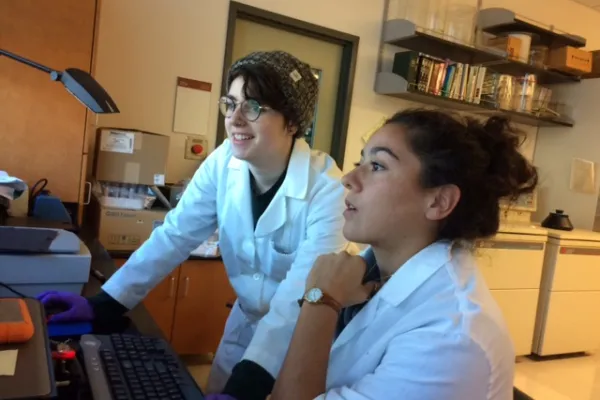Starting Early: Student Research Leads to Success
Research & Inquiry

Published December 14, 2017
Maggie Pacheco ’19 discovered her passion the summer of her very first year at Smith, when she started working in Professor Stan Scordilis’ biochemistry lab. “That’s where I really got to experience being a researcher,” she says.
Pacheco has built on that experience ever since, including presenting findings from her studies of rat muscle proteins at a national conference last month; her career goal is to be a biomedical engineer.
Claire Vinson ’19 also did research as a first-year student. Her project—which involved exploring women’s history documents in the Sophia Smith Collection—inspired Vinson to continue taking humanities courses while pursuing a major in chemistry. Next semester, she’ll study history, literature and language in Spain, on her way to a career in public health.
Providing research experiences for students early in their Smith careers is an integral part of the college’s educational mission. Through programs such as AEMES and STRIDE, Smith offers multiple early avenues for hands-on research. Over the last 10 years, the proportion of all Smith students who participate in independent research during their college career has grown to 60 percent.
Those activities have led to academic success: AEMES participants, for example, are more likely to persist in STEM and in scientific research. In addition, over the past dozen years, Smith students have been awarded more Fulbright Fellowships than those at peer liberal arts institutions across the nation.
The college is now working on expanding course-based research in Smith classrooms. A new four-year CUR (Council on Undergraduate Research) Transformations grant from the National Science Foundation will support innovative strategies for student research in STEM fields that can be applied across disciplines at Smith.
“This grant will focus on making course-based research more intentional in chemistry and biology, where many faculty and lab instructors are pursuing research projects,” says Kevin Shea, professor of chemistry and faculty director of the sciences. “We hope the discussion, implementation and assessments of research-based curricula will serve as models for others.”
Here’s what Pacheco and Vinson had to say about how their early research experiences helped shape their Smith careers:
Maggie Pacheco ’19, biochemistry major, member of the Pioneers soccer team
“I came to Smith as an AEMES scholar, which meant I got paired with a mentor who really helped keep me grounded. I started working in the [Scordilis] biochemistry lab the summer of my first year, and that’s where I really got to experience being a researcher on my own project. When my first experiment failed miserably, Professor Laura Katz—my AEMES adviser— said, ‘Good job! You failed. Now you know what it’s like to be a scientist.’ Research is about figuring out what no one knows yet, so it’s all about figuring out the mechanism of the failure. It’s also about learning what to do when things go right—developing research questions for the next step.
What I’m working on now is proteomics, researching how skeletal muscle composition changes as a result of age and diet. When we presented [at the Annual Biomedical Conference for Minority Students] in November, I felt that even among other bright and talented people, Smith was still brag-worthy because of our work ethic and the rigor of our research.”
Claire Vinson ’19, chemistry major
“I did a summer program at Smith that got me interested in the archives. My STRIDE project with [Associate Professor of History] Marnie Anderson was about the life of Charlotte DeForest, who was president of a college in Japan in 1915. I wrote an essay about DeForest’s work at the Manzanar internment camp for Japanese Americans during World War II, which included an entry she wrote on the day the atomic bomb was dropped. (She was horrified!)
I came to Smith to do a STEM major, but the research I did for my STRIDE project made me realize I didn’t want to be so single focused. I’m in Professor Kate Queeney’s chemistry lab, and I’m also taking an anthropology course this semester about public health in East Asia. I’m thinking about a career in public health. What helped me most in my first year was connecting with a professor and having a mentor—my teas with Marnie Anderson. That’s what makes Smith unique compared to a big university—the chance to have mentoring relationships with professors.”
Longtime biochemistry lab partners Emily Morris '19 (left) and Maggie Pacheco '19 review data Pacheco is using for her research on the effect of diet and aging on muscle physiology.